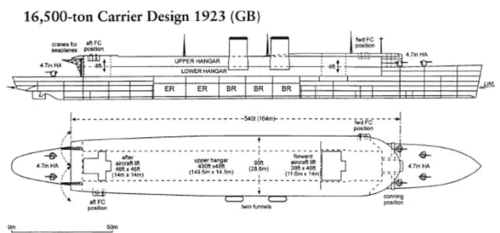- Joined
- 22 April 2012
- Messages
- 2,258
- Reaction score
- 2,315
The opening British position at Washington was for a 25,000 ton individual ship limit and a 125,000 ton total tonnage limit for aircraft carriers that would allow the RN to possess five 25,000 ton carriers. The ultimate agreement was very close to this. The figure of five for the RN came from July 1920 Admiralty conference report that called for three in the Home Fleet and two for overseas commitments and refitting though I have also seen it expressed as two for each of two main fleets and one refitting. To my knowledge no specific RN 25,000 ton design study from 1920/21 has ever been found but DNC was well aware that new build ships would be much more efficient at carrying aircraft than the conversions, it was estimated that building new from the keel up would have produced weight savings as follows:
Furious: 22,000tons, new build 18,000 tons for a saving of 4,000 tons (30 knots)
Eagle: 23,000tons, new build 15,000tons for a saving of 8,000 tons (24 knots)
The conversions were less efficient than new construction in terms of aircraft carriage, an even more significant issue in light of the tonnage caps enshrined in the Washington Treaty, but they had the advantage of being about half the cost (£3m versus £6m) of new construction so proceeded.
Whilst no 1920/21 25,000 ton new build RN design has been found there are three design proposals for new build ships from 1923:
Scheme A: 10,000 tons, loosely based on Hermes with a flush deck, 5x 5.5" + 3x4" AA guns and 24 (or 27?) knot speed (27 aircraft)
Scheme B: 16,500 tons, double hangar with near Furious aircraft capacity, 6 x 4.7" AA guns and 34.5 knot speed (35 aircraft)
Scheme C: 25,000 tons, 6x8" guns (50 aircraft)
I find Scheme C most interesting as it maps to the pre-treaty thinking. However, Scheme B was chosen for development and grew in weight to 17,200 tons before being abandoned, hangar height was 15ft. This design was preferred as the Washington Treaty meant allowable tonnage was at a premium and it had been in intended for the 1925/26 programme but was progressively deferred - first to 1929 and then to 1932. John Jordan has a sketch (attached) of this design in his book Warships after Washington and gives the following additional specs:
Dimensions: 765ft x 80ft
Machinery: four shaft geared turbines, 120,000 SHP
Armour: Belt 2" deck 1"
Furious: 22,000tons, new build 18,000 tons for a saving of 4,000 tons (30 knots)
Eagle: 23,000tons, new build 15,000tons for a saving of 8,000 tons (24 knots)
The conversions were less efficient than new construction in terms of aircraft carriage, an even more significant issue in light of the tonnage caps enshrined in the Washington Treaty, but they had the advantage of being about half the cost (£3m versus £6m) of new construction so proceeded.
Whilst no 1920/21 25,000 ton new build RN design has been found there are three design proposals for new build ships from 1923:
Scheme A: 10,000 tons, loosely based on Hermes with a flush deck, 5x 5.5" + 3x4" AA guns and 24 (or 27?) knot speed (27 aircraft)
Scheme B: 16,500 tons, double hangar with near Furious aircraft capacity, 6 x 4.7" AA guns and 34.5 knot speed (35 aircraft)
Scheme C: 25,000 tons, 6x8" guns (50 aircraft)
I find Scheme C most interesting as it maps to the pre-treaty thinking. However, Scheme B was chosen for development and grew in weight to 17,200 tons before being abandoned, hangar height was 15ft. This design was preferred as the Washington Treaty meant allowable tonnage was at a premium and it had been in intended for the 1925/26 programme but was progressively deferred - first to 1929 and then to 1932. John Jordan has a sketch (attached) of this design in his book Warships after Washington and gives the following additional specs:
Dimensions: 765ft x 80ft
Machinery: four shaft geared turbines, 120,000 SHP
Armour: Belt 2" deck 1"
Attachments
Last edited:

